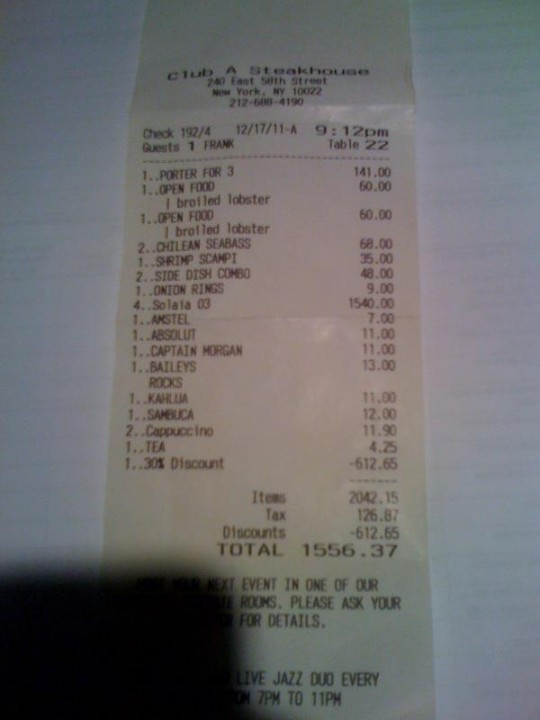Investigation: Saving 30% on Dinner is Great, But How Can This Last?
December 21st, 2011
This receipt (swiped from a Facebook post for Savored.com) shows a discount of $612.65 on dinner from Club A Steakhouse in Manhattan.
So here’s what I want to know: How can restaurants that participate in Savored.com (Facebook | Twitter) and Restaurant.com (Facebook | Twitter) actually draw enough business to cover the costs of these extraordinary discounts? I get that this is a marketing expense, and not every check is discounted, which reduces the average per-check discount. And to fill more seats and possibly create some momentum, perhaps you’re willing to eat into your huge profits on alcohol. But I can’t help feeling that:
This is a tactic for desperate restaurants on their last leg that are probably deeply in debt (and that I probably don’t want to go to because they’re not good enough to make it without discounting), and;
This cannot be profitable, particularly if people return and get the discount every time, and/or if the average bar tab is low.
I can see trying this tactic for a defined period of time to fill empty tables if you believe that your restaurant is brilliant but that not enough people know about it. (Although watching Kitchen Nightmares with Gordon Ramsey would lead me to believe that usually it’s not an awareness problem, but a food and/or ownership problem.)
But more often, I see restaurants participating over long periods of time, and I don’t understand how they continue to absorb the cost of the promotion. I wonder if there is a typical break-even point? Average length of participation? Rates of failure for businesses who discount like this? I’d be curious to see some profitability analysis of these sites and promotions. Sounds like a great thesis topic for a PhD in economics. Short of signing on for that, I’d welcome hearing from anyone with expertise in this area. @BrianRaganUX on Twitter.

 Troubled experiences that need a little counseling ("Interventions"), great experiences that serve as role models ("Inspirations"), and curious or questionable experiences teetering on the brink of a breakdown ("Investigations"). We'll showcase smart experience strategies, great interaction design, and thoughts on transforming marketing meltdowns into model experiences. Our mission: help companies create great experiences that attract attention, convert new customers, generate engagement and cultivate loyalty.
Troubled experiences that need a little counseling ("Interventions"), great experiences that serve as role models ("Inspirations"), and curious or questionable experiences teetering on the brink of a breakdown ("Investigations"). We'll showcase smart experience strategies, great interaction design, and thoughts on transforming marketing meltdowns into model experiences. Our mission: help companies create great experiences that attract attention, convert new customers, generate engagement and cultivate loyalty. 


